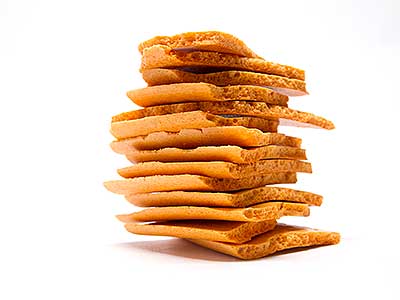August 4, 2014
Intermède

mousse de carotte séchée
(crispy carrot foam)
I recently have had the opportunity to eat at a number of modern, high-end, hard-to-get-a-seat-at restaurants. These have been great meals full of attractive dishes and exotic ingredients. For the most part, everything was tasty. A few times, some of the dishes seemed to be on the menu more for effect than taste. Rarely was there more than one or two mouthfuls of a single item. Even some dishes were only a few bites. Some of the dishes were so complex that instructions were provided by the waitstaff as to the order that the items on the dish should be consumed. The dinners were beginning to feel like looking at (and devouring) a dozen or so Dutch still-life paintings from the seventeenth century.
The still-life painters generally didn’t just paint a single fish or piece of fruit. They painted a panoply food. Modern chefs don’t just serve a hunk of meat and a couple vegetables on the side. They create a still life on the plate using a multitude of preparations. Visually, it’s quite exciting. Gastronomically, it’s sometimes overwhelming and disappointing. I find more and more that I prefer meals represented by Edward Weston’s Pepper No. 30 over those represented by Abraham van Beijeren’s Pronkstilleven.
This blog is built as much as possible upon dishes made from a minimal number of ingredients and simple techniques. Recipes that make use of one or two ingredients are often the most challenging and the most rewarding. Dishes like pudding de maïs (corn pudding) and essence de tomate (tomato essence) are my versions of Weston’s pepper.
I divide my “miniature” dishes in these blog postings, and when I serve them to guests, into either amuse-bouche, intermèdes, or mignardise. For every intermède posting, there are two mignardise postings, and six amuse-bouche postings. The intermèdes are the hardest to conceive and write about. So far, there have been two sources. I come across a dish that seems appropriate and different enough from those already posted—how many mousse, sorbet, and soda recipes can one site hold without just repeating the same technique with different central ingredients—or I conceive of a recipe from whole cloth. The following recipe is an amalgamation of both processes.
I tend to awake slowly, and often I use the time for structured thinking. I haven’t gone as far as writing down a subject for the following morning, but I do consciously think about the proper subject first thing when I awake. The other day it was what could I do for my next intermède posting? My first thought was to do a dehydrated foam since I didn’t have one of those yet. My next thought was using a vegetable juice for the base. Carrots came to mind next since they are cheap, and I’ve been getting some very sweet ones at my local farmers market. When searching the Internet for some recipe guidance—a dry foam would require the proper surfactant—the first page to pop up was that of a person attempting to make every recipe from the Alinea Cookbook. Scrolling down the page, I found his preparation of Alinea’s crispy carrot foam.Since I already had all the ingredients in house, it seemed worth a try.
I have an inexpensive centrifugal juicer I found on sale for $25 in 2000 at a local chain department store. For the price it works exceedingly well, but it’s a pain to clean. I bought it mainly for juicing asparagus. It probably only gets used about twice a year. It works fine for carrots, my only concern for this recipe.
I simplified the recipe a bit, lazy as I am. It didn’t make sense to me to dilute the juice, heat it, and then chill it. So I recalculated the volumes of a couple of the ingredients. I left the methylcellulose percentage the same, even though at about 3% it’s much higher than the 1 to 2% I normally see recommended for Methocel F50.
215 g
strained carrot juice
35 g
finely granulated sugar
8 g
Methocel F50
1. Add the juice and sugar to the bowl of a stand mixer. Using a stick blender, agitate the juice until the sugar is completely dissolved. Place the bowl in your refrigerator until the liquid is well chilled.
2. While agitating the liquid with a stick blender, sprinkle the methylcellulose over the surface. Continue until the methylcellulose is hydrated and well dispersed.
3. Attach the bowl to the mixer fitted with a whisk attachment. Whisk at high speed until the foam supports medium to stiff peaks, about 10 minutes.
4. Spread the foam evenly over the surface of a liquid-appropriate tray in a food dehydrator. Dehydrate at 55 °C (131 °F) until the foam is dry and crisp, about 6 hours.
5. Carefully cut the dried foam into pieces suitable for serving.
Yield: about 16 servings.
© 2014 Peter Hertzmann. All rights reserved.
